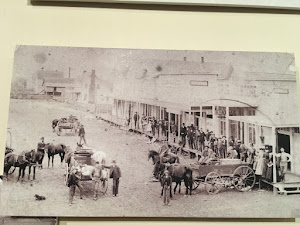Today, Texas A&M-Commerce students are extremely loyal to their mascot, president, and school—as a staff/part-time faculty member, I see the passion among the student body during sports games, club competitions, Homecoming, and Spirit Week celebrations (despite the woes of the ongoing pandemic). This positive fidelity has long been present in the state institution and demonstrated in various ways during the mighty Lions’ 132-years existence. One specific incident that showcases the fierce loyalty ET students had towards their school and principal was a time when President (and founder) William L. Mayo was harassed by a jealous educator from a neighboring town before being rescued by the pupils he had in class that morning.
 |
| William Leonidas Mayo (in the center) sits with his ETNC A.B. graduating class, 1905. |
Prior to the turn of the twentieth century, education for many white boys and girls in North Texas was considered a necessity and families soon began requesting towns to construct schools and colleges. Sherman, suitably called the “Athens of Texas,” was home to several of the best private schools in the state, including the Presbyterian Church’s (USA) Austin College and its female equivalent, Kidd-Key College (previously known as North Texas Female College). Greenville became the stomping grounds for the Methodist and Baptist schools, including Wesley College and Burleson College. Henry College, located in neighboring Campbell, was founded by local businessmen Henry T. Bridges and Henry T. Eastman and opened its doors in 1892. The pair's goal was to "provide a first class college education for poor boys and girls in Hunt and the nearby counties," an echo of Mayo's own ambitions three years prior. According to the county historian Jackson Massey, Bridges, who served as president of the new college, put up $15,000 of his own money to fund the construction of Henry College's administration building on the south side of the town. In an effort to boost enrollment numbers, Bridges publicized the attractive fact that six of the 11 faculty had college degrees. Since there was a large number of colleges in North Texas trying to increase their enrollment and endowment during the tough times of the financial Panic of 1893, competition ensured.
 |
| Mayo was reportedly jealous of Henry College's robust academic curriculum, which included classes in music, elocution, bookkeeping, and stenography. |
William Mayo thrived on
competition, and like many principals during the 1890s, he bluntly mocked the academic curriculums
of other colleges in North Texas in attempts to lure more prospective students to
East Texas Normal College. In an August 1896 article, Mayo criticized Bridges’ advertising methods. In return, Principal Bridges
denounced the Northern-educated Mayo, labeling him a “useless Carpetbagger.” On August 24,
the war of words became violent when Bridges (who, according to students, was known to "use his fist and foot frequently" to maintain discipline at his college) traveled to Commerce in his
horse-buggy and confronted Mayo. After the ETNC founder refused to sign a
statement retracting his claims, Bridges “drew his pistol” and shot at his
intended target twice, missing both marks. Thereafter, “Bridges jumped from the
buggy with a whip” and proceeded to give Mayo “15 or 20 lashes.” The brawl
attracted a group of ETNC students, who, as staunchly-loyal Lions, rescued
their president and drove Bridges out of town.
According to records, both
educators were arrested and placed under a $500 bond. Bridges, despite getting personal revenge, returned to Campbell a couple days later only to find that the community and the college's Board of Trustees condemned his
actions, and later refused to support Henry College (the school closed in 1901 after funds dried up and enrollment declined). After
the violent altercation, President William L. Mayo would never underestimate
the loyalty and ferocious lion spirit that his ETNC students had.



No comments:
Post a Comment